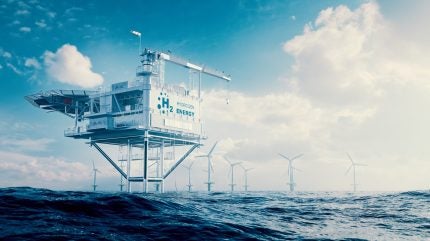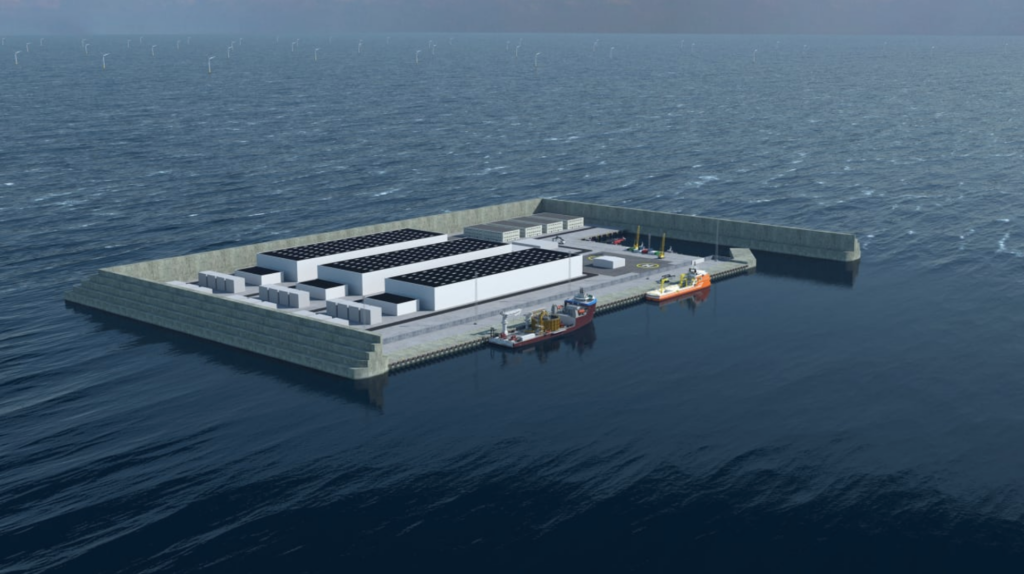
It is now widely accepted that the key to net zero will be the roll-out of huge amounts of solar and wind power. These renewables are cheap, can be installed in most parts of the world and can be used beyond the power sector to decarbonise transport, industry and heating through electrification.
More dramatic and high-tech solutions maintain their allure, however. Solar farms in the Sahara or installed in space, and nuclear fusion all have their champions.
One of the more accessible high-tech solutions to net zero, which would complement offshore renewables and could become reality within the next decade, are energy islands.

These islands, or hubs, would gather green electricity from vast arrays of wind turbines out in the gusty open sea and send that power back onshore via interconnectors. They would connect different countries and could also feature electrolysers and/or utility-scale batteries to maximise the renewable energy they can capture without curtailment.
Winds out in the open sea are less intermittent and more powerful. Turbines can be so far out they are not visible from shore: a solution to the ‘not in my backyard’ problem and a clear rebuttal to those who argue that renewables take up too much land. Data from the Global Wind Atlas shows that the majority of Europe’s technical wind potential lies far out in the North and Baltic Seas.
Of course, there are significant challenges and expense involved. While the technology needed to build wind islands exists, neither the construction of large artificial islands, nor of large-scale hydrogen electrolysers out at sea, nor of large-scale floating wind (for when the sea floor gets too deep) has been done before.
Despite these challenges, the experts Energy Monitor spoke to were broadly positive about the role that energy islands may play in the future.
“Given the big differences in operations for nearshore and far-shore offshore wind, it does seem to make sense from a cost perspective,” says Christian Eriksen from the Bellona Foundation, an NGO. “There is a real case for energy islands as they would allow you to build and operate far-shore wind from relative proximity.”
“Energy islands are an exciting prospect that could allow greater roll out of renewables at lower overall cost,” says Sam Boorman, a consultant at FTI Consulting working on interconnectors in the North Sea. “In some cases, by adding storage capabilities like batteries and hydrogen to large offshore wind farms to make energy islands, it is possible to harness even more of the wind’s energy and reduce the costs of transmitting this energy back to shore – therefore reducing the costs to customers of achieving net zero”.
A number of early-stage energy island projects are being developed in European waters, led by Denmark and Belgium, while in the Netherlands earlier plans to develop energy islands have now been shelved. No countries have began constructing their islands, shows data from industry association WindEurope, and all are expected at the end of the decade at the earliest.
Denmark in particular is seeking to blaze the energy islands trail and repeat what it achieved in the 1990s with offshore wind, by being the first country in the world to build and successfully integrate an island into its energy system. The country is planning to build islands in both the North Sea and Baltic Sea with the ultimate ambition to use the facilities to also provide renewable power to other European countries. The projects are immensely complex: the North Sea island, for example, is expected to cost DKr210bn ($29.82bn) and involves partnerships with Germany, Belgium and Luxembourg.
Hybrid interconnectors
The UK and Germany are aiming for net-zero electricity sectors by 2035, with the rest of Europe needing a similar aspiration to achieve net zero by 2050. The nearness of these targets means that, even with the greatest political will, it is unlikely energy islands will play a major role in the initial manifestations of net-zero energy systems.
Nevertheless, a key technology for energy islands will likely play a significant role in the development of zero-carbon grids: hybrid, or multipurpose, interconnectors. These are effectively interconnectors with an offshore wind farm in the middle, which sell the electricity generated by the farm to whichever country has higher wholesale power costs at a given moment. If the wind is not blowing, the cables theoretically bypass the farm and simply sell power between countries, as is the case with standard interconnectors.
“Hybrid interconnectors are much simpler proposals than building actual islands,” says Eriksen. Interconnection generally is “foundational” to renewables-dominated grids, he adds, as the ability to offload or buy electricity from other countries will aid with system balancing.
[Keep up with Energy Monitor: Subscribe to our weekly newsletter]
The primary benefit of hybrid interconnection is that costs can be lowered, with two pieces of vital infrastructure – the interconnector and the offshore wind farm – merged into one. Using a hybrid interconnector also reduces the footprint on land compared with separate interconnectors, which means that developers are less likely to run into public opposition.
Installing hybrid cables represents a significant step towards the kind of grids that will be needed for net zero. “Ultimately, it is more efficient to use hybrid offshore wind farms,” says Christoph Zipf from WindEurope. “By connecting different hybrid offshore wind farms, Europe can build up a meshed and interconnected offshore wind grid, which will allow for smart electricity flows, making electricity available where it is needed.”
There is currently only one hybrid offshore wind farm in operation, the Kriegers Flak project that connects Germany with Denmark. In addition, Estonia, Latvia and Norway are all planning hybrid interconnection projects, according to WindEurope.
The UK – which has both the largest offshore wind pipeline and some of the greatest technical wind potential in Europe – is also planning for new hybrid interconnectors, which the government says will be linked to the 50GW of new offshore wind capacity the country is building by 2050 as part of its energy security strategy.
“The government’s target is 50GW of offshore wind by 2030, which represents an enormous increase in generation," explains John Greasley from National Grid Ventures (NGV), a company leading the development of interconnectors in the UK. “There will be many periods when the output of these wind farms outstrips the UK’s demand. The export opportunity for the UK will be massive.”
Speaking at WindEurope’s recent annual conference in Bilbao, Spain, the president of NGV, Cordi O’Hara, said the company is currently in talks to develop hybrid interconnectors with Belgium, the Netherlands and Norway.
Interconnection challenges
It can be exciting to think about the positives of a Europe-wide, interconnected, zero-carbon grid, but there are significant challenges to getting there.
As with standard interconnectors, hybrid interconnectors are incredibly expensive, sometimes running into billions. While standard interconnectors 'only' require agreement between respective TSOs, regulatory bodies and amenable government policy, it becomes a whole lot harder with hybrid interconnectors, because offshore wind investors and power utilities also become involved.
“While the benefit of the hybrid solution might be absolutely clear from a societal perspective at European scale, the distribution of costs and benefits might be unequal,” explains Monika Morawiecka from think tank the Regulatory Assistance Project. “Offshore wind developers are clearly the main proponents of these solutions as a connection to two countries gives greater flexibility, revenue certainty and less risk of curtailment.”
Finding an operational framework that is also profitable for TSOs and investors – and efficiently manages cross-border flows – remains a challenge. There is a new rule in the EU that cross-border interconnectors must be available for international trade 70% of the time – and because it is likely that the connected wind farm will be generating and selling power more than 30% of the time, this presents a problem.
There is currently no single regulatory, licensing and permitting system to work through these challenges, adds Morawiecka, and that makes finding solutions more difficult as the first pioneering systems need to gain individual approval and acceptance from a whole host of different authorities.
New transmission projects are already chronically delayed at the permitting stage, shows data from the European Agency for the Cooperation of Energy Regulators, and that is largely for projects much less complicated than hybrid interconnectors.
Every weapon in the armoury
Given all these challenges, and the prospect of years of delay, is it worth investing hope in hybrid interconnectors, let alone even larger energy islands? The answer from the analysts Energy Monitor spoke to was a resounding yes.
“The nature of the challenge we face is so big that nothing should be ruled out at this stage,” says NGV’s Greasley. “The North Sea is likely to develop incrementally, so in the shorter term, offshore wind farms connecting to multipurpose (or hybrid) interconnectors via offshore platforms is an achievable step in the evolution to a fully meshed grid.”
When it comes to regulatory challenges, the sense in the industry is that the political will is now there to see through even the most complicated of proposed projects. “The attractiveness of offshore wind is now so compelling to governments that we will work through all the problems until we reach the scale of wind net zero requires,” suggests Alastair Dutton from the Global Wind Energy Council.
“This is not to say that we don’t need onshore wind, solar and other renewable technologies, but the challenge of net zero is so great that we should aim for everything," adds Morawiecka. "Energy islands are a daunting prospect, but they do hold the promise of cheaper and more efficient power, and it is likely they will have a role to play.”
This article originally appeared in our sister publication Energy Monitor.



